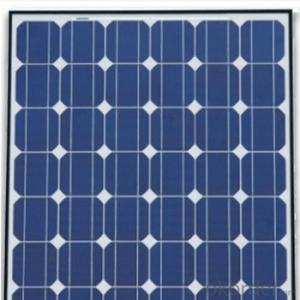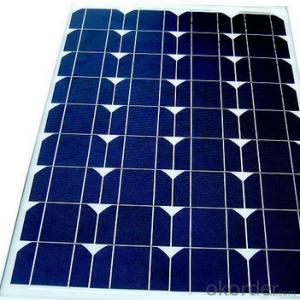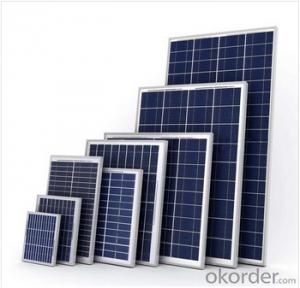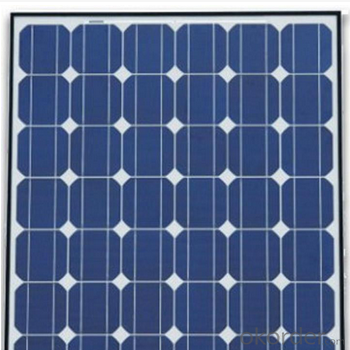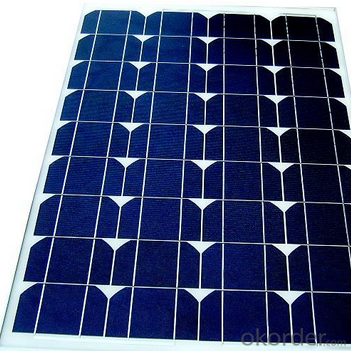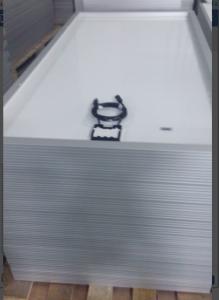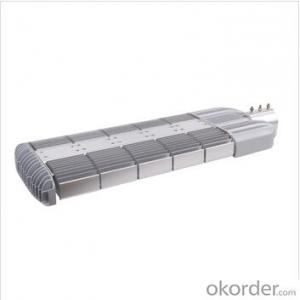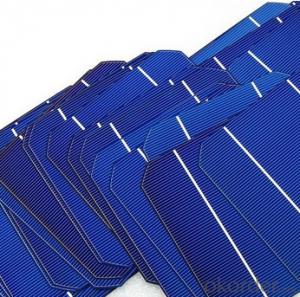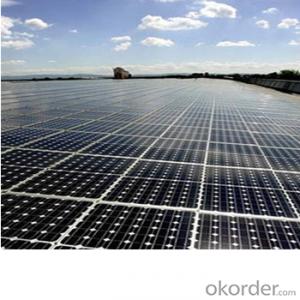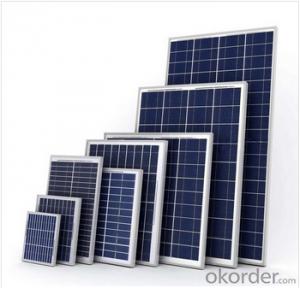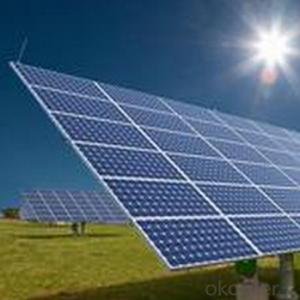Marine Solar Panels - High Efficiency Poly/Mono Solar Module Ice-17
- Loading Port:
- China main port
- Payment Terms:
- TT OR LC
- Min Order Qty:
- 200 watt
- Supply Capability:
- 500000 watt/month
OKorder Service Pledge
OKorder Financial Service
You Might Also Like
Instruction
Format : 156 mm × 156 mm ± 0.5 mm
Thickness: 210 μm ±40 μm
Front (-) : 1.5mm bus bars (silver),blue anti-reflection coating (silicon nitride)
Back (+) : 2.5mm wide soldering pads (silver) back surface field (aluminium)
Feature
1. High efficiency and High power.
2. Long-term electrical stability.
3. Lowest price and Fastest delivery.
4. Good quality and best service.
5. Bulk supply
6. Trusted Warranty
7. Big Sale
8. More than 25 years on the lifetime.
Images

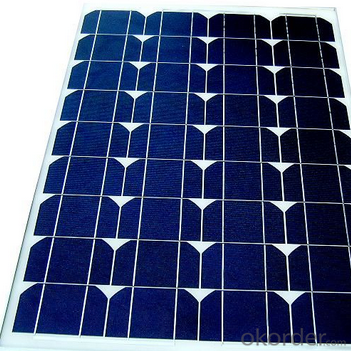
Specification
Electrical Characteristic of Mono Solar Cells
Efficiency (%) | Pmpp (W) | Umpp (V) | Impp (A) | Uoc (V) | Isc (A) | FF (%) |
18.35 | 4.384 | 0.526 | 8.333 | 0.63 | 8.877 | 78.39% |
18.20 | 4.349 | 0.526 | 8.263 | 0.63 | 8.789 | 78.54% |
18.05 | 4.313 | 0.525 | 8.216 | 0.63 | 8.741 | 78.32% |
17.90 | 4.277 | 0.524 | 8.161 | 0.629 | 8.713 | 78.04% |
17.75 | 4.241 | 0.523 | 8.116 | 0.629 | 8.678 | 77.70% |
17.60 | 4.206 | 0.521 | 8.073 | 0.628 | 8.657 | 77.36% |
17.45 | 4.170 | 0.519 | 8.039 | 0.628 | 8.633 | 76.92% |
17.30 | 4.134 | 0.517 | 8.004 | 0.626 | 8.622 | 76.59% |
17.15 | 4.098 | 0.516 | 7.938 | 0.625 | 8.537 | 76.80% |
17.00 | 4.062 | 0.512 | 7.933 | 0.625 | 8.531 | 76.18% |
16.75 | 4.002 | 0.511 | 7.828 | 0.625 | 8.499 | 75.34% |
16.50 | 3.943 | 0.510 | 7.731 | 0.625 | 8.484 | 74.36% |
FAQ
We have organized several common questions for our clients,may help you sincerely:
1. What’s price per watt?
A: It’s depends on the quantity, delivery date and payment terms of the order. We can talk further about the detail price issue. Our products is high quality with lower price level.
2. Can you tell me the parameter of your solar cells?
We have different series of cells with different power output, both from c-si to a-si. Please take our specification sheet for your reference.
3. How do you pack your products?
We have rich experience on how to pack the panels to make sure the safety on shipment when it arrives at the destination.
- Q: I don't have a regulator connected as they are a little expensive for a pensioner, If I join the panels into line to the battery bank from the roof should that be OK.?
- You can do this, but it isn't the best way to go. There is no problem with joining the solar panels. There are two ways to do this, in series and in parallel. A series combination will add the voltages that each panel is producing together, but not the amperages. For example, if five panels are producing 6V at 300mA each, the end result will be 30V at 300mA for a series array. A parallel combination combines the amperages of all the panels, but not the voltages. So, in our earlier example, five panels at 6V and 300mA would provide 6V and 500mA (.5A) if wired in parallel. Series-parallel combinations are also possible, giving some of the benefits of each method. This would probably better understood by doing a quick search on Google Images for series, parallel, and series-parallel. You CAN connect the solar panels directly to your battery bank with no regulator. Unfortunately, without a regulator, the connection is two-way. When the sun is out and the solar panels are producing more voltage than the batteries, the batteries will charge. However, when the panels are producing less voltage than the batteries, the batteries will instead send power into the solar panels, which will be dissipated and wasted. The panels may charge your batteries during the day, but they will discharge them at night.
- Q: i want to instal solar ligth in my garden
- hello, okorder /
- Q: I need a 2v (500-800ma) solar panel that in can fit on a 24inx4in flat surface. Where can i get one this size and with this power?
- Build okorder /
- Q: Can solar panels be installed on streetlights?
- Yes, solar panels can be installed on streetlights. This allows the streetlights to generate their own electricity from sunlight, reducing reliance on the electrical grid and promoting sustainability.
- Q: Can solar panels be used to power electric vehicles?
- Yes, solar panels can be used to power electric vehicles. Solar power can be harnessed to charge the batteries of electric vehicles, providing a renewable and sustainable source of energy. This allows electric vehicles to operate with reduced reliance on traditional grid electricity and contributes to a greener transportation system.
- Q: Can solar panels be used for powering an electric fence?
- Yes, solar panels can be used to power an electric fence. Solar panels convert sunlight into electricity, which can be stored in batteries or used directly to power various devices, including electric fences. This off-grid solution is eco-friendly and cost-effective in areas without access to electricity.
- Q: lately i have been interested in solar power. i own my own home and in Texas it's HOT, so my A/C is always on and that light bill is like $300.00 a month. i was looking at other light companies but then i remembered that there are the so called solar power but i dont knowknow to start or how it would work to power the a/c machine...pls help
- We are in the UK, but we now have two systems, one which heats the water and the other generates electricity via PV panels. You need to have a roof area facing in the correct direction and at a suitable pitch. If the sun is hitting the roof at an oblique angle the loss of benefit is high. The system that heats the water has the fastest pay back time. Our water has been hot since we had the system installed despite a poor summer here. Over here we can export surplus electricity created by the PV panels back to the national grid, and they buy that surplus. We often have surpluses during the day, but obviously when it is dark and we use electricity, we sort of buy it back. In the 6 months since it was installed, we have generated about 85% of our needs. Our best day was when we generated 46% of our needs. As you may know, we have had rain and floods over here, but to-day we still generated 22% of our needs and we put on several loads of washing. we have kept a spreadsheet of all teh figures. We are very pleased with ours, and we got a grant, but it was very expensive for the PV system. i'd recommend it, though. i have grandchildren and I feel we have to do something to preserve resources for them and to help combat climate problems. Make sure you have done other things - such as made sure your insulation etc is as good as it can be.
- Q: Can solar panels be used to power a hospital?
- Yes, solar panels can be used to power a hospital. Solar panels convert sunlight into electricity, which can be used to meet the energy needs of various facilities, including hospitals. By installing a solar power system, a hospital can generate clean and renewable energy, reducing its reliance on traditional grid power and potentially saving costs in the long run. However, the feasibility of using solar panels to power a hospital depends on factors such as the hospital's energy requirements, available space for solar panel installation, and the local climate conditions. Additionally, backup power solutions may be necessary to ensure uninterrupted electricity supply during periods of low sunlight or system maintenance.
- Q: Can solar panels be used for off-grid living?
- Yes, solar panels can be used for off-grid living. They provide a reliable and sustainable source of electricity by converting sunlight into usable energy. This makes them ideal for powering homes, cabins, or even recreational vehicles in remote areas where access to the utility grid is limited or unavailable. Solar panels enable off-grid living by storing excess energy in batteries, allowing for electricity usage during nighttime or cloudy days.
- Q: How do solar panels affect the property's carbon footprint?
- Solar panels can greatly reduce a property's carbon footprint by generating clean and renewable energy. Since solar panels generate electricity by harnessing the power of the sun, they do not emit any greenhouse gases or pollutants during operation. By reducing reliance on fossil fuels and grid electricity, solar panels help to offset carbon emissions that would have been produced by traditional energy sources, thus positively impacting the property's carbon footprint.
Send your message to us
Marine Solar Panels - High Efficiency Poly/Mono Solar Module Ice-17
- Loading Port:
- China main port
- Payment Terms:
- TT OR LC
- Min Order Qty:
- 200 watt
- Supply Capability:
- 500000 watt/month
OKorder Service Pledge
OKorder Financial Service
Similar products
Hot products
Hot Searches
Related keywords
